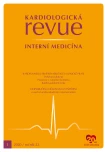Nicotine, smoking and cardiovascular risks – basic concepts
Authors:
Králíková E.
Authors‘ workplace:
Ústav hygieny a epidemiologie 1. LF UK a VFN v Praze Centrum pro závislé na tabáku, III. interní klinika– klinika endokrinologie a metabolizmu 1. LF UK a VFN v Praze
Published in:
Kardiol Rev Int Med 2020, 22(1): 26-28
Overview
Smoking roughly doubles the risk of a cardiovascular (CV) event. Smokers usually abstain from smoking in the first days following a CV event, but after a longer period of time they relapse to smoking again very easily– after a year, one-half of them are smoking again. Tobacco dependence is a chronic, relapsing disease. We should actively ask about smoking during every contact with every patient, but especially with patients after a CV event – even a small amount of tobacco smoke damages the blood vessels. We should support non-smokers in abstinence, including exposure to passive smoking, prevent smoking relapses , offer assistance to smokers during a short intervention, or in cases of a lack of time, recommend the nearest intensive treatment option, mobile app or telephone quitline. Nicotine alone is not without cardiovascular effects (mainly cardiac action, sympathomimetic), but what is toxic is primarily the effect of substances produced by combustion, whether free radicals, carbon monoxide, polyhalogenated hydrocarbons or any of the several thousand other substances contained in tobacco smoke. If the patient does not want or is unable to stop using nicotine, we can offer a less risky form without the substances contained in the smoke.
Keywords:
smoking – cardiovascular rehabilitation – nicotine – damage reduction
Sources
1. Národní autorizační středisko pro klinické laboratoře při ČLS JEP: „SCORE algoritmus“ pro výpočet desetileté pravděpodobnosti fatální kardiovaskulární příhody. Dostupné na: http:/ / www.naskl.cz/ score-algoritmus-pro-vypocet-desetilete-pravdepodobnosti-fatalni-kardiovaskularni-prihody.
2. Mayer B. How much nicotine kills a human? Tracing back the generally accepted lethal dose to dubious self-experiments in the nineteenth century. Arch Toxicol 2014; 88(1): 5–7. doi: 10.1007/ s00204-013-1127-0.
3. McNeillA, Brose LS, Calder R et al. E-cigarettes: an evidence update. A report commissioned by Public Health England. London: Public Health England 2015. Available at: https:/ / assets.publishing.service.gov.uk/ government/ uploads/ system/ uploads/ attachment_data/ file/ 733022/ Ecigarettes_an_evidence_update_A_report_commissioned_by_Public_Health_England_FINAL.pdf.
4. McNeill A, Brose LS, Calder R et al. Vaping in England:an evidence update February 2019. A report commissioned by Public Health England. London: Public Health England 2019. Available at: https:/ / assets.publishing.service.gov.uk/ government/ uploads/ system/ uploads/ attachment_data/ file/ 781748/ Vaping_in_England_an_evidence_update_February_2019.pdf.
5. St Helen G, Jacob IP, Nardone N et al. IQOS: examination of Philip Morris International‘s claim of reduced exposure. Tob Control 2018; 27 (Suppl 1): S30–S36. doi: 10.1136/ tobaccocontrol-2018-054321.
6. Králíková E, Zvolská K. Kardiovaskulární rizika kouření, nikotinu a jeho nových forem. Kap Kardiol 2017; 9(2): 64–68.
7. Benowitz NL, Burbank AD. Cardiovascular toxicity of nicotine: implications for electronic cigarette use. Trends Cardiovasc Med 2016; 26(6): 515–523. doi: 10.1016/ j.tcm.2016.03.001.
8. Snaterse M, Scholte Op Reimer WJ, Dobber Jet al. Smoking cessation after an acute coronary syndrome: immediate quitters are successful quitters. Neth Heart J 2015; 23(12): 600–607. doi: 10.1007/ s12471-015-0755-9.
9. Botha P, Peaston R, White K et al. Smoking after cardiac transplantation. Am J Transplant 2008; 8(4): 866–871. doi: 10.1111/ j.1600-6143.2007.02119.x.
10. Hofmann P, Benden C, Kohler M et al. Smoking resumption after heart or lung transplantation: a systematic review and suggestions for screening and management. J Thorac Dis 2018; 10(7): 4609–4618. doi: 10.21037/ jtd.2018.07.16.
11. Chaloupka J, Siegelová J, Špinarová L et al. Doporučení pro rehabilitaci u nemocných s kardiovaskulárním onemocněním. Cor Vasa 2006; 48(7–8):K127–K145.
12. Králíková E, Češka R, Pánková A et al. Doporučení pro léčbu závislosti na tabáku. Vnitr Lek 2015; 61 (5 Suppl 1): 1S4–1S15.
13. Benowitz NL, Pipe A, West R et al. Cardiovascular safety of varenicline, bupropion, and nicotine patch in smokers: a randomized clinical trial. JAMA Intern Med 2018; 178(5): 622–631. doi: 10.1001/ jamainternmed.2018.0397.
14. Šedová L, Tóthová V, Chloubová I et al. Kouření – ovlivnitelný rizikový faktor nemocí srdce a cév. Kardiol Rev Int Med 2019; 21(2): 106–110
15. Rosolová H. Kouření tabáku a individualizovaný přístup v prevenci a léčbě. Kardiol Rev 2011; 13(2): 96–98.
Labels
Paediatric cardiology Internal medicine Cardiac surgery CardiologyArticle was published in
Cardiology Review

2020 Issue 1
Most read in this issue
- ECG diagnostic of first contact by means of eight steps
- Nicotine, smoking and cardiovascular risks – basic concepts
- Recommended examination in infectious serology in patients with cardiovascular disease
- Influence of physical activity on lowering blood pressure in patients with arterial hypertension
